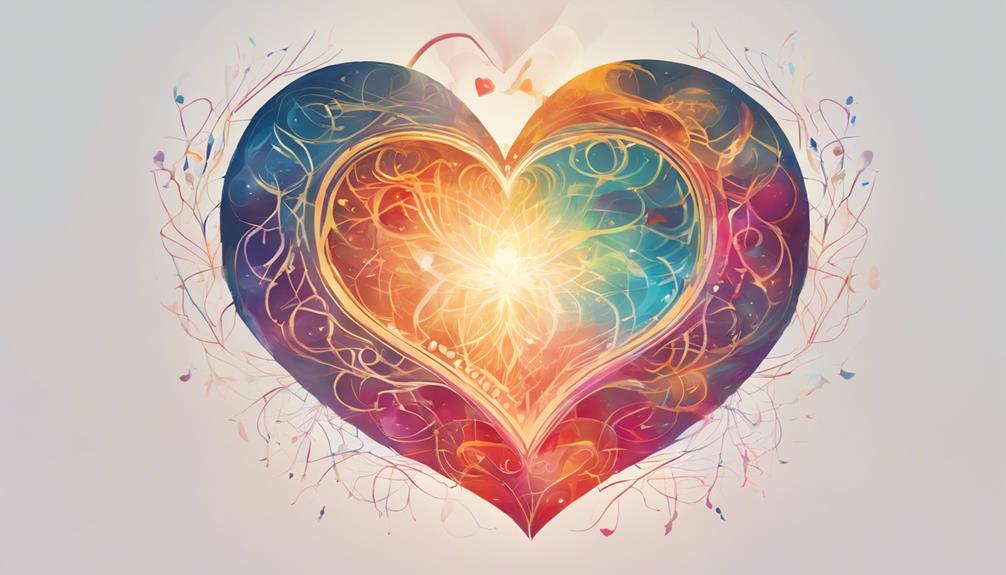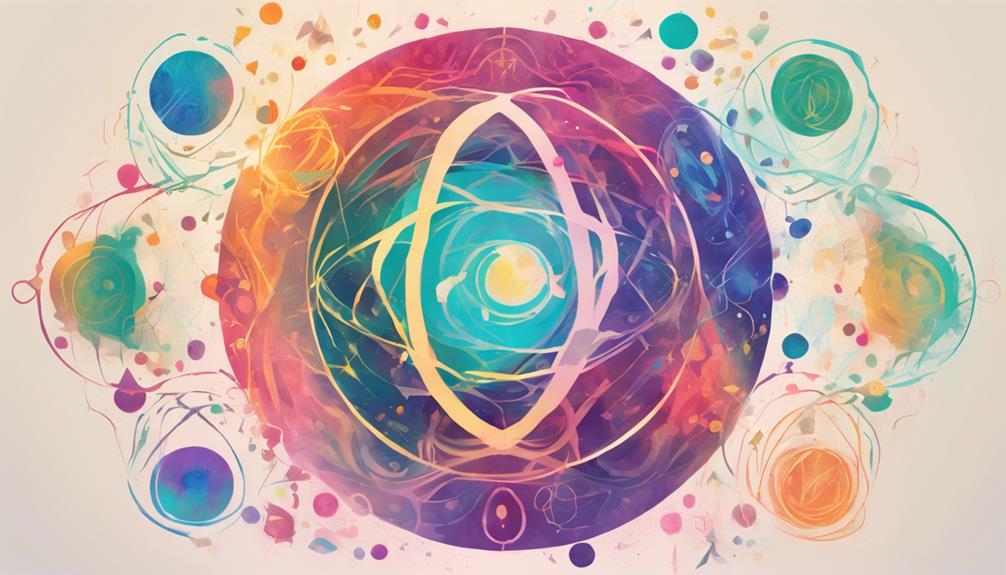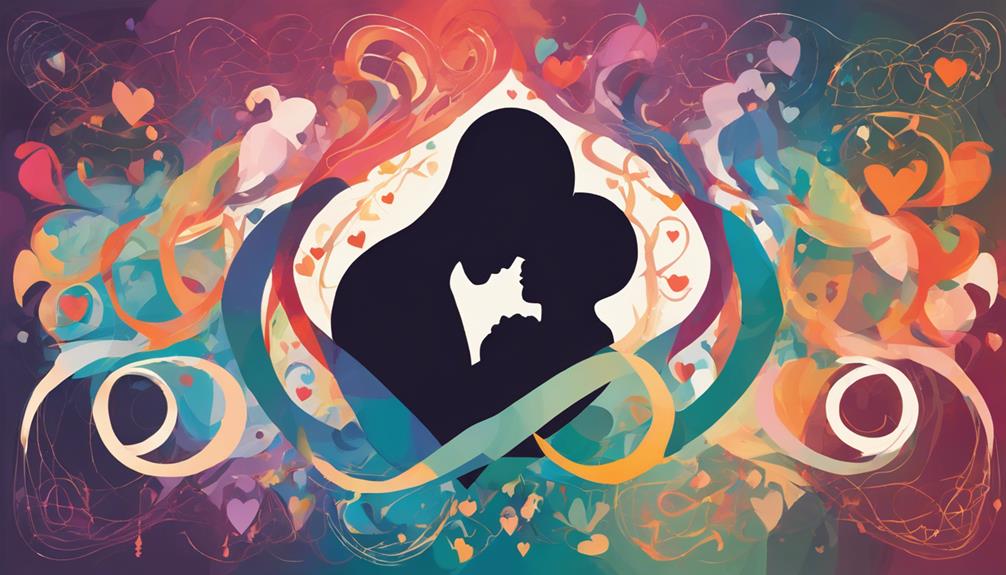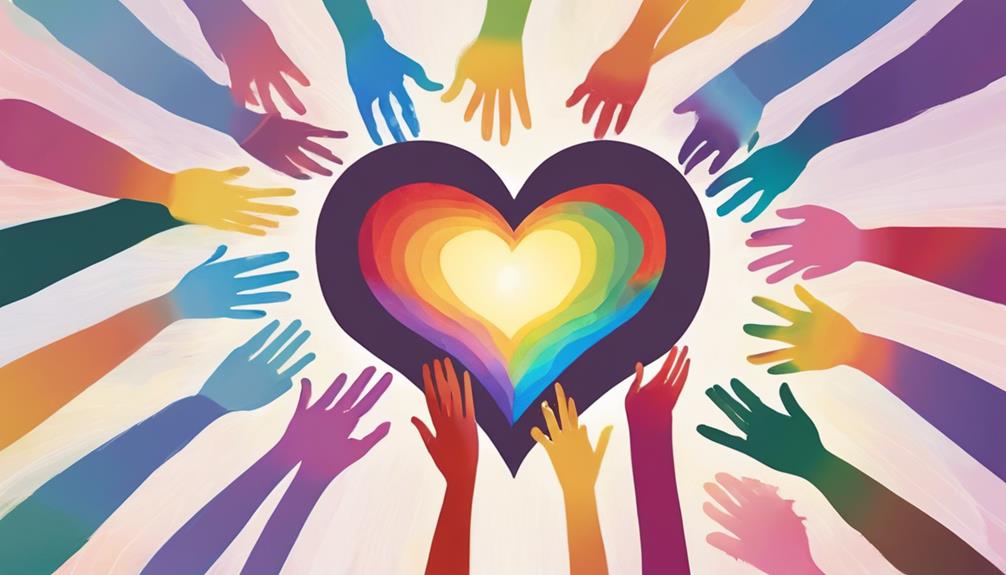Summary
- 1 What is pansexuality?
- 2 Historical Context
- 3 Pansexuality vs. Bisexuality
- 4 Pansexuality Vs. Omnisexuality
- 5 Pansexuality vs. Polysexuality
- 6 Gender spectrum and attraction
- 7 Common myths
- 8 Coming out as pansexual
- 9 Representation in the media
- 10 Personal Stories
- 11 Pansexuality and Relationships
- 12 Challenges faced
- 13 Supporting pansexual individuals
- 14 Promoting inclusiveness
- 15 Frequently Asked Questions
- 15.1 How does pansexuality intersect with cultural and religious beliefs?
- 15.2 Are there specific symbols associated with pansexual pride?
- 15.3 Can pansexuality affect a person's mental health or well-being?
- 15.4 How can pansexuality be explained to children?
- 15.5 What is the role of pansexuality in the LGBTQ+ community?
Pansexuality means being attracted to people regardless of their gender identity. Unlike bisexuality, which usually involves attraction to two or more gender identities, pansexuality is limitless and inclusive. You may find yourself attracted to men, women, nonbinary people, and others based on their personality and connection to you rather than their gender. This overcomes barriers by focusing on the individual, not traditional categories. Understanding this can help you navigate and sustain diverse attractions. Curious about the nuances and distinctions in pansexuality? Keep exploring to enrich your understanding.
What is pansexuality?

Pansexuality is a sexual orientation in which you are attracted to people regardless of their gender. This means that you may feel attracted to men, women, nonbinary people, and anyone else. Your attraction is not limited by someone's gender identity or expression. Instead, you are open to loving and connecting with people based on who they are as individuals.
Imagine being at a party and meeting someone with a fantastic sense of humor, who shares your interests and is kind and caring. If you are pansexual, their gender does not affect whether you feel attracted to them. What matters is their personality, their feeling and how you connect with them.
It is important to note that pansexuality is different from bisexuality. While bisexuality means being attracted to two or more genders, pansexuality means attraction without considering gender at all. It is like having a wider field of potential connections. This orientation emphasizes that love and attraction can cross traditional gender boundaries, making your potential for connection limitless.
Understanding pansexuality helps break down stereotypes and promotes a more inclusive view of relationships and attraction.
Historical Context
Throughout history, many cultures have recognized forms of attraction beyond the traditional gender boundaries, although they did not use the term 'pansexuality'. For example, the ancient Greeks celebrated love and desire regardless of gender. Their mythology is full of stories of gods and mortals who had relationships that could be considered pansexual today. In many indigenous cultures around the world, individuals were revered for their ability to love people of all kinds.
In the Indian subcontinent, texts such as the Kama Sutra recognized different sexual attractions. These ancient writings did not necessarily label people, but recorded behaviors and relationships that went beyond male-female couples. In more recent history, the growth of the LGBTQ+ movement in the 20th century has brought greater visibility to various sexual orientations, including pansexuality. Activists and thinkers have begun to challenge binary views of gender and attraction, leading to a Broader understanding of human sexuality.
Pansexuality vs. Bisexuality

As you delve into pansexuality and bisexuality, it is crucial to understand their differences. Pansexuality means being attracted to people regardless of their gender, while bisexuality usually involves attraction to two or more genres. Think of it this way: a pansexual person might be attracted to someone based on their personality, while a bisexual person might be attracted to specific gender identities.
Conceptual differences
To understand the conceptual differences between pansexuality e bisexuality, it is critical to understand how each term defines attraction. Bisexuality typically refers to being attracted to two or more genders, often interpreted as attraction to both men and women. However, it can also include the attraction to nonbinary individuals. On the other hand, pansexuality means being attracted to people regardless of their gender. Pansexual people often describe their attraction as. not limited by gender at all.
Imagine being at a party and meeting new people. If you are bisexual, you might find yourself attracted to men, women, and potentially nonbinary people. If you are pansexual, you might feel that attraction without considering gender at all. It is about the person, not their gender identity.
Think of it this way: bisexuality can be seen as recognizing and being open to multiple genders, while pansexuality is more about attraction to individuals without any gender boundaries. Both identities are valid and important, but they interpret the concept of attraction differently. Understanding these distinctions helps to respect and recognize the different ways in which people experience love and attraction.
Scope of Attraction
Understanding the extent of attraction in pansexuality versus bisexuality can help you appreciate the unique ways in which people make connections with others. Pansexuality is characterized by attraction to individuals regardless of their gender or gender identity. This implies that a pansexual person might be attracted to someone who is male, female, non-binary, or genderqueer regardless of gender.
On the other hand, bisexuality typically refers to attraction to two or more genders, often male and female. However, it is important to note that bisexuality can also include attraction to nonbinary individuals. The "bi" in bisexuality does not rigidly confine attraction to only two genders; rather, it is the ability to be attracted to more than one gender.
Imagine you are at a gathering and feel interested in various individuals in attendance. If you are pansexual, you might find that gender in no way influences who you are attracted to. If you are bisexual, you might still feel attraction to a variety of individuals, even though gender might play a role in that attraction. Both orientations celebrate different connections, but in slightly different manners. Understanding these nuances can help you better understand and appreciate the experiences of others.
Identity and Expression
Identity and expression in pansexuality and bisexuality often reveal how individuals relate to their sense of self and how they present their attraction to others. If you identify as pansexual, you may feel attraction to individuals regardless of their gender. This means you look beyond traditional gender boundaries, embracing the person as a whole. You might say, 'I am attracted to individuals, not genders.'
On the other hand, if you identify as bisexual, you are attracted to multiple genders, typically both your own and others. Bisexuality can sometimes be misunderstood as limited only to men and women, but many bisexual individuals are also attracted to nonbinary and genderqueer people. You could explain it as, 'I am attracted to more than one gender.'
Understanding these identities helps you understand that both pansexual and bisexual individuals can have different attractions. What matters most is how you feel and how you choose to express it. If you are talking to someone, knowing these differences can help you better understand their experiences. Remember, how someone identifies is deeply personal and will shape their unique path in love and attraction.
Pansexuality Vs. Omnisexuality
You might wonder how pansexuality differs from omnisexuality, since both involve an attraction to all genders. To understand these distinctions, let's look at them in detail.
- Definition and Focus: Pansexuality is often defined as attraction to individuals regardless of their gender. This means that gender does not affect who a pansexual person finds attractive. On the other hand, omnisexuality is attraction to all gender identities but with recognition of gender distinctions. Omnisexual individuals may be aware of gender in their attraction but are still open to all gender identities.
- Identity and Perception: Pansexual individuals might describe their attraction as 'gender neutral,' indicating that they do not consider gender a factor. On the other hand, omnisexual individuals recognize and sometimes welcome the various gender identities to which they are attracted.
- Community and Use: Both terms are used in the LGBTQ+ community, but people may prefer one term over the other based on their own comfort and identity. Some feel that 'pansexual' better represents their experience, while others identify more with 'omnisexual'.
Understanding these nuances can help you better understand how different and personalized sexual orientation can be. It's about finding the label that best fits you or others, emphasizing respect and inclusiveness.
Pansexuality vs. Polysexuality

In comparing pansexuality and polysexuality, you will notice some key differences. Pansexuality involves attraction to people regardless of their gender, while polysexuality means attraction to multiple, but not all, genders. Imagine someone who is pansexual as having a wide and unlimited vision, and someone who is polysexual as having a wider but selective field of vision.
Differences in the spectrum of attraction
Understanding the differences between pansexuality and polysexuality can help clarify how these unique attractions fit into the broader spectrum of human sexuality. While both orientations involve attraction to multiple genders, they differ in scope and focus.
Pansexuality is characterized by attraction to people regardless of their gender. If you identify as pansexual, you may find yourself attracted to someone because of their personality, energy, or other qualities, regardless of their gender. This means that your love and attraction have no boundaries related to gender identity.
Polysexuality, on the other hand, involves attraction to multiple genders, but not all of them. If you are polysexual, you might be attracted to men and nonbinary individuals but not to women, or any other combination that makes sense to you. Unlike pansexuality, polysexuality recognizes gender as a factor in attraction but does not exclude multiple genders.
Here is a quick overview to help you:
- Scope of Attraction: Pansexuality includes all genders; polysexuality includes many but not all.
- Consideration of Gender: Pansexuality does not consider gender; polysexuality considers it.
- Personal Experience: Your individual feelings and attractions determine whether you identify as pansexual or polysexual.
Scope of gender inclusiveness
In examining the scope of gender inclusiveness of pansexuality compared to the polysexuality, it is important to recognize how each orientation interacts distinctly with the concept of gender. When you identify as pansexual, your attraction extends to people regardless of their gender. You can think of yourself as attracted to the same person, whether male, female, non-binary, or any other gender. Pansexuality emphasizes that gender does not limit your romantic or sexual interest.
On the other hand, if you identify yourself as polysexual, your attraction spans multiple genres, but not necessarily all. You may feel attracted to people who are masculine, feminine, and nonbinary, but perhaps not to those who identify otherwise. Polysexuality recognizes the diversity of genders but recognizes that attraction can still have its limits.
Imagine being at a party and feeling a connection with several people there. As a pansexual person, you would not consider their gender in your attraction at all. As a polysexual person, you might be attracted to many people in the room, but not all of them. Understanding these distinctions helps clarify how each orientation uniquely navigates the diverse landscape of gender identities.
Identity and Labels
Let us now examine how the identities and labels of pansexuality and polysexuality shape personal experiences and self-understanding. Pansexuality is about being attracted to people regardless of their gender. It is about embracing the full spectrum of gender identities. On the other hand, polysexuality involves attraction to multiple, but not necessarily all, genders. These distinctions can greatly influence how individuals understand and express their identities.
Imagine identifying as pansexual. You may feel a deep connection to the idea that love and attraction cross gender boundaries. This may foster a sense of inclusiveness and fluidity in your relationships. Conversely, if you identify as polysexual, you may find comfort in recognizing the specific genders to which you are attracted, without including every gender identity.
Here are three key points to clarify these labels:
- Inclusiveness: Pansexuality is often seen as more inclusive, embracing all gender identities.
- Specificity: Polysexuality allows attraction to multiple genders, but not necessarily to all of them.
- Self-understanding: Both labels offer unique ways to understand and navigate personal attraction.
Understanding these differences helps you choose the label that best aligns with your experiences and feelings.
Gender spectrum and attraction
People who identify themselves as pansexuals often find themselves attracted to others regardless of where they are placed in the gender spectrum. This means that they do not limit their attraction only to men or women. Instead, they might be attracted to people who identify as non-binary, genderqueer, or in any other gender identity.
Imagine meeting new friends at a party. You might feel a connection with someone who is a man, another person who is a woman, and another who identifies as nonbinary. For a pansexual person, the gender of each individual does not determine attraction. It is about the person and their unique qualities.
The gender spectrum is broad and includes many identities besides the traditional male and female. Some people may identify as agender, meaning that they do not feel bound to any gender. Others might be genderfluid, meaning that their gender identity changes over time. Pansexuality embraces this diversity, seeing the potential for attraction in anyone, regardless of where they place themselves on this spectrum.
Common myths

Many myths surround pansexuality, leading to misunderstandings about what it actually means. A common myth is that pansexuality is just a phase or trend. This misunderstanding can ignore genuine feelings and identities. Pansexuality is a valid sexual orientation, not a temporary state.
Another myth is that pansexual people are attracted to everyone and anyone. This is not true. Pansexuality means being attracted to people regardless of their gender, but it does not mean being attracted to every single person you meet. Just like anyone else, pansexual people have personal preferences and boundaries.
Here is a quick overview of some other common myths:
- Myth: Pansexuality is the same thing as bisexuality. While both orientations involve attraction to multiple genders, pansexuality specifically means attraction regardless of gender.
- Myth: Pansexual people cannot have monogamous relationships. Being pansexual does not affect the ability to commit to a single partner.
- Myth: Pansexuality is excessively sexual. Pansexual people can have a full range of relationships, from romantic to platonic, just like anyone else.
Understanding these myths helps to appreciate the true essence of pansexuality and support those who identify with it.
Coming out as pansexual
Coming out as pansexual can be a deeply personal journey that begins with understanding your own feelings. You will then face the challenge of sharing this part of you with your loved ones, which can bring both relief and anxiety. Remember, it is your story to tell and there is no right or wrong way to do it.
Embarking on the journey to declare yourself pansexual may seem like venturing into uncharted territory, full of exciting discoveries and challenging moments. It is a journey where you will learn a lot about yourself and what pansexuality means to you. Here are some steps to help you navigate this journey of self-discovery:
- Self-Education: Understanding pansexuality is essential. Read books, watch videos, and follow social media accounts that discuss pansexuality. Learning from the experiences of others can provide clarity and validation.
- Reflection: Take time to reflect on your feelings and attractions. Keeping a journal can be a great tool for this. Write about your experiences and thoughts to better understand your emotions and how you identify.
- Connecting with the Community: Finding community can make a big difference. Look for LGBTQ+ groups or online forums where you can share your journey and hear from people who are experiencing or have experienced similar feelings.
Sharing with loved ones
When you are ready to share your identity pansexual with your loved ones, it can be helpful to start by choosing a safe and comfortable environment for conversation. This could be a quiet room at home where you feel comfortable or a favorite coffee shop where you and your loved one have had meaningful conversations in the past. The goal is to create a space where you can both talk and listen openly.
Start honestly expressing your feelings. You might say, 'I want to share something important about myself. I realized I am pansexual, which means I am attracted to people independently by their gender.' Simple and clear explanations can help your loved ones understand. They may have questions, and that's fine. Be prepared to Explain what pansexuality means For you personally.
Representation in the media

In recent years, pansexuality has gained more visibility in the media through different characters in TV programs, movies, and books. You may have noticed that some of your favorite programs now include pansexual characters, which helps normalize and provide a better understanding of this identity.
Here are three notable examples:
- TV Programs: In the popular series *Brooklyn Nine-Nine*, there is Rosa Diaz, who declares herself pansexual, offering viewers a relational and positive representation of pansexuality.
- Film: The movie *Deadpool 2* features the character Deadpool, who is openly pansexual. This mainstream film brought pansexuality to the forefront in a fun and accessible way.
- Books: In literature, Alice Oseman's *Radio Silence* includes a pansexual protagonist, offering readers a chance to see themselves represented in a deep and meaningful story.
These examples help break down prejudices and create more inclusive narratives. When pansexual characters are seen, it is easier to understand that attraction is not limited by gender. The more representation there is, the more people can relate, learn and accept. It is a step toward a more inclusive society where everyone feels seen.
Personal Stories
Hearing personal stories from pansexual individuals can offer valuable perspectives on their experiences and help foster greater understanding and empathy. Imagine talking with Alex, who describes their journey in realizing they are pansexual. Alex shares how they felt attraction to people regardless of gender. This revelation was not immediate; it took time to understand and accept their feelings.
Another story comes from Jamie, who talks about the confusion he faced before finding the term 'pansexual.' Jamie always knew he was different, but he could not understand why. Discovering the term felt to him like finding a missing piece of the puzzle. It allowed Jamie to fully embrace his identity and feel seen.
Then there is Casey, who tells how she came out to her family and friends. Casey's story highlights both the challenges and the liberating feeling of being true to oneself. Some reactions were supportive, while others required more time and explanation.
These personal stories highlight the different experiences within the pansexual community. Each path is unique, but all emphasize the importance of acceptance and understanding. By listening to these stories, you can gain a greater appreciation of what it means to be pansexual.
Pansexuality and Relationships

Have you ever wondered how pansexuality shapes relationship dynamics? When you are pansexual, your attraction is not limited by gender. This can open up a wonderful range of possibilities in your romantic life. Here's how:
- Unlimited Attraction: Being pansexual means being able to feel attraction to people regardless of their gender. Whether someone identifies as male, female, non-binary or any other gender, your attraction is about the person, not the gender.
- Greater Understanding: Because pansexuality encompasses a wide range of gender identities, you often develop a deeper understanding and empathy for different experiences and points of view. This can make your relationships more compassionate and open.
- Communication: Open and honest communication becomes essential. You will find that discussing your feelings and boundaries with your partner(s) helps foster strong, healthy relationships.
Imagine meeting someone who doesn't fit into traditional gender categories but still feel that undeniable spark. That is the beauty of pansexuality. It's about looking beyond labels and connecting on a human level. So if you are pansexual, welcome the endless possibilities that your attraction brings to relationships. It is a journey of love, understanding and connection.
Challenges faced
Being pansexual can bring a unique set of challenges. One of the main problems you may encounter is the lack of understanding e awareness. Many people do not know what pansexuality means, which can lead to confusion And sometimes even to the invalidation of your identity. You may hear people say, 'Isn't that just bisexual?' or 'You must be attracted to everyone.' These misconceptions can be frustrating and painful.
Another challenge is the deletion. In conversations about sexual orientation, pansexuality is often overlooked. This can make you feel invisible and excluded, especially in LGBTQ+ spaces where other identities are more commonly discussed. It is difficult when your experiences are not recognized or validated by the communities you are supposed to be a part of.
Discrimination and prejudice are also common obstacles. Some people may not accept your pansexuality, leading to negative comments or even the refusal. This may occur in families, workplaces or social circles. You may also face stereotypes, such as being perceived as 'confused' or 'greed,' which are unfair and inaccurate.
Navigating relationships can also be complicated. Potential partners may not fully understand your orientation, leading to misunderstandings or problems of trust. These challenges can make it difficult to feel secure and accepted in your romantic life.
Supporting pansexual individuals

Supporting pansexual individuals means fostering an environment of understanding, respect, and inclusiveness. It is important to recognize that pansexuality is about being attracted to people regardless of their gender. Here are three key ways to support pansexual individuals:
- Personal Education: Take the time to learn about pansexuality. Read articles, watch videos, and ask questions. The more you know, the better you can understand and support.
- Use Inclusive Language: Pay attention to your words. Avoid making assumptions about the gender of someone's partner. Instead of saying 'boyfriend' or 'girlfriend,' you can use terms like 'partner.
- Being an Ally: Oppose discrimination and stereotyping. If you hear someone make an insensitive comment, take action. Your support can make a big difference.
For example, if a pansexual friend shares their experiences with you, listen without judgment. Ask respectful questions if you are unsure about something. Showing genuine interest and empathy helps build trust and comfort. Remember, every little bit counts. By creating a supportive and inclusive environment, you are helping pansexual individuals feel seen, respected and valued.
Promoting inclusiveness
Creating a supportive environment for pansexual individuals naturally leads to promoting greater inclusiveness in all aspects of society. When you accept pansexuality, you are recognizing that love and attraction are not limited to gender. This way of thinking can help you see the importance of inclusivity for everyone, regardless of their background or identity.
Imagine that you are part of a sports team. If one team member feels excluded because of his or her sexual orientation, it affects the morale and performance of the entire team. By fostering an environment in which everyone feels included and accepted, you are not just helping that person; you are strengthening the entire team.
In your workplace, use inclusive language and celebrate diversity. Simple actions like using gender-neutral terms and recognizing different cultural holidays go a long way. Think about how you can make public spaces more accessible. Whether it's adding ramps for wheelchair users or providing multilingual signage, these changes show that you value inclusivity.
Inclusiveness is not just a buzzword. It is about making concrete changes that enable everyone to feel valued and respected. When you commit to inclusiveness, you are advocating for a world in which everyone, including pansexual individuals, can thrive.
Frequently Asked Questions
How does pansexuality intersect with cultural and religious beliefs?
When analyzing the pansexuality, can sometimes collide or merge with the cultural and religious beliefs. Some cultures and religions may not fully understand or accept this reality, generating challenges. However, there are also communities and faiths that welcome love in all its forms. These are. strike a balance between one's identity and the beliefs one grew up with, and sometimes, to create new paths to understanding.
Are there specific symbols associated with pansexual pride?
Yes, there are specific symbols related to pansexual pride. You will often find the pansexual flag, which has three horizontal stripes: pink for attraction to women, yellow for attraction to nonbinary people and blue for attraction to men. Another symbol is the infinite heart, which combines the infinity sign with a heart, representing a love without limits. These symbols help express identity and unity within the pansexual community.
Can pansexuality affect a person's mental health or well-being?
Yes, the pansexuality can affect your mental health and your wellness. If you feel accepted and understood, it can increase your happiness and self-confidence. On the other hand, facing discrimination or misunderstanding could cause stress and anxiety. Finding supportive communities and mental health resources is essential. Remember, embracing your true self is critical to your overall well-being and you are not alone in this journey.
How can pansexuality be explained to children?
When you explain the pansexuality to children, you can tell them that it is about loving or appreciating people as they are, not just based on whether they are male or female. You could use an example like, 'Imagine you have friends who are male and female, and you appreciate them all equally for their personality, not for their gender.' Keep things simple and focus on the idea of love and friendship.
What is the role of pansexuality in the LGBTQ+ community?
Pansexuality plays a crucial role in the LGBTQ+ community by highlighting the importance of attraction beyond gender. It shows that love and attraction are not limited only to male or female. You can be attracted to anyone, regardless of their gender identity. This helps create a more inclusive and welcoming community where everyone feels seen and valued. Pansexuality helps break down barriers and promotes understanding and acceptance of all identities.
